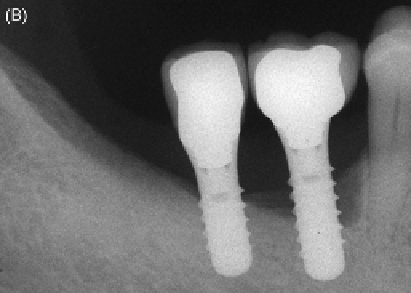Biomedical Engineering Reference
In-Depth Information
FIGURES 6.6
(A) Clinical and (B) radiographic images of peri-implantitis.
The signs and symptoms of peri-implantitis include bleeding on probing, increased probing pocket
depth (
3 mm; generally noninfected implants allow the probe to penetrate approximately 3 mm),
mobility of the implant, suppuration, pain along with radiological evidence of vertical destruction of
crestal bone (which is often saucer-shaped) (
Figure 6.6
).
In a comparative study with different metals used in the fabrication of implants, titanium showed
considerable antibacterial activity when compared with other metals like gold, cobalt, vanadium,
aluminum, chromium, and iron
[102]
. This study concluded that the rank order of antibacterial
activity expressed by these metals was gold
titanium
cobalt
vanadium
aluminum
chro-
mium
iron. After gold, titanium exhibited a high degree of antibacterial properties. By contrast,
a few other
in-vitro
and
in-vivo
studies have reported that titanium does not have a significant bacte-
riostatic effect on strains of oral bacteria
[103,104]
. Numerous approaches have focused on modify-
ing the titanium surface to render it resistant to bacterial attachment, thereby reducing infection rate
and the risk of inflammation with antibacterial surfaces
[105]
. A recent study compared the adhesive
and antimicrobial properties of nano- and microscale samples of zinc oxide (ZnO) and titanium oxide
(TiO
2
) to staphylococcal cells and osteoblasts
[106]
. ZnO was selected in this study because of its
antimicrobial properties and TiO
2
was selected because it typically forms on titanium implants in the
body. The authors concluded that, when compared to their microscale counterparts, the nanoscale
ZnO and TiO
2
led to reduced staphylococcal cell adhesion and increased osteoblast adhesion. Such
nanoscale coatings of ZnO on titanium implants may play a vital role in decreasing the formation of
biofilm and thereby the subsequent peri-implant pathology. Photocatalytic bactericidal nanoscale TiO
2
when illuminated under ultraviolet radiation releases antibacterial active-oxygen species like OH,
HO
2
, HO
2
and H
2
O
2
[107,108]
. Such TiO
2
nanocoatings on titanium dental implants can decrease
early bacterial colonization.
Silver-based antimicrobials are of interest due to their specific antibacterial activity and the non-
toxicity of the active Ag
to human cells. Antimicrobial silver-coated titanium surface (TiAg) when
evaluated for its specific antimicrobial activity showed significant antimicrobial potency against
Staphylococcus epidermis
and
Klebsiella pneumoniae
strains and at the same time, no cytotoxic


